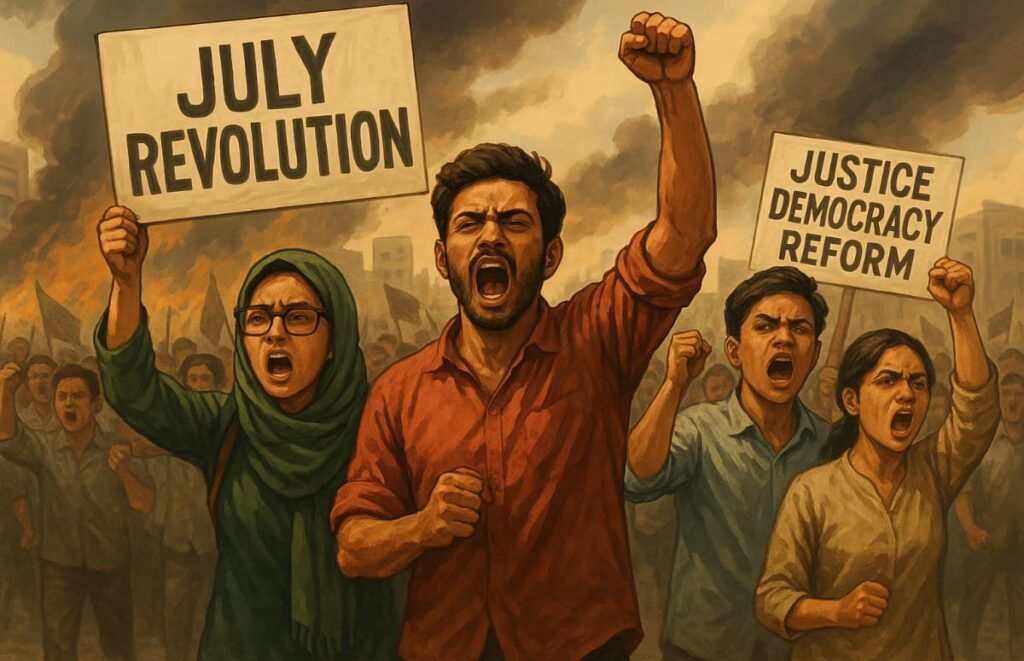July Revolution In Bangladesh Paragraph For All Classes Of Students

July Revolution in Bangladesh (For HSC Students)
The July Revolution in Bangladesh: A Turning Point in Modern History (200 words)
The July Revolution of 2024 in Bangladesh marked a significant chapter in the nation’s political landscape. Triggered by a controversial court ruling reinstating a discriminatory quota system in public service recruitment, the movement rapidly evolved from peaceful student protests into a nationwide uprising. It was primarily led by university students demanding fair treatment and the abolition of outdated reservation policies. The protests highlighted deep-rooted frustrations with governance, inequality, and suppression of dissent.
Key Highlights of the July Revolution:
- Origin of the Movement: It began in early June 2024, when the High Court’s ruling reignited long-standing discontent over the quota system in government jobs.
- Mass Mobilisation: By mid-July, thousands of students across major cities, including Dhaka, Chittagong, Rajshahi, and Sylhet, took to the streets. The movement quickly gained support from civil society and opposition groups.
- Government Response: The government responded with police crackdowns, internet blackouts, and mass arrests. The most tragic moment occurred when a university student was killed in a police firing.
- Political Fallout: On August 5, under mounting pressure, Prime Minister Sheikh Hasina resigned and left the country. This unprecedented move led to the formation of an interim government led by Nobel laureate Dr. Muhammad Yunus.
- Legacy of the Revolution: The July Revolution is now seen as a democratic resurgence, reflecting the power of youth and civil disobedience in shaping national policy.
This revolution reshaped the country’s future and sent a strong message about the value of justice, merit, and public participation in governance. It remains a symbol of hope and change in Bangladesh’s democratic journey.
Paragraph: 400 words
The July Revolution in Bangladesh was a groundbreaking student-led uprising that shook the political foundations of the country in 2024. Sparked by the reinstatement of a controversial quota system in government jobs, the movement rapidly grew into a nationwide protest for justice, meritocracy, and democratic accountability.
Background and Rise of the July Revolution in Bangladesh
It all began in early June 2024, when a High Court verdict declared the 2018 quota cancellation invalid. This decision outraged university students, who saw it as a step backwards. Within days, the July Revolution in Bangladesh gained momentum as students organized peaceful protests in Rangpur, Dhaka, Chittagong, Rajshahi, and other cities.
Key Events of the July Revolution in Bangladesh:
- Legal Trigger: The High Court ruling acted as a catalyst for mass dissatisfaction.
- Mass Protests: Universities became the heart of the revolution, with thousands demanding change.
- Violent Crackdowns: On July 16, a student named Abu Sayeed was killed during a police operation in Rangpur an incident that fueled national outrage.
- Government Collapse: Facing unprecedented resistance, Prime Minister Sheikh Hasina resigned on August 5 and left the country.
- Transitional Government: Nobel laureate Dr. Muhammad Yunus was appointed head of the interim government tasked with restoring democratic order.
Legacy of the July Revolution in Bangladesh
The July Revolution in Bangladesh has become a symbol of youth power and peaceful resistance. It wasn’t just a fight against quotas but a call for accountability, transparency, and a government that listens. The revolution awakened a new political consciousness in the country and inspired hope for a fairer, more democratic future.
Anti-Discrimination Student Movement
FAQ
The July Revolution was a student-led uprising in 2024 protesting the reinstatement of a controversial quota system in government jobs.
It began after a High Court ruling reinstated a discriminatory quota system, triggering mass student protests demanding merit-based recruitment.
University students were at the forefront, later supported by civil society and opposition groups demanding justice and transparency.
On August 5, 2024, Prime Minister Sheikh Hasina resigned and left the country amid growing unrest, leading to a transitional government.
The revolution led to a change in leadership, the formation of an interim government, and sparked a new wave of democratic consciousness.
Dr. Muhammad Yunus, a Nobel laureate, was appointed to lead the interim government after the resignation of Prime Minister Sheikh Hasina.
It revitalised public participation and youth activism and set a precedent for peaceful resistance against authoritarian governance.
There is noticeably a bundle to learn about this. I assume you made certain nice points in features also.
I am commenting to let you know what a fantastic encounter my friend’s princess experienced reading yuor web blog. She picked up a lot of things, with the inclusion of how it is like to possess a wonderful giving mood to have men and women completely gain knowledge of specified complicated topics. You actually surpassed her expectations. Thanks for imparting these productive, safe, edifying and as well as unique thoughts on that topic to Lizeth.
take love
I saw a lot of website but I believe this one has something special in it in it